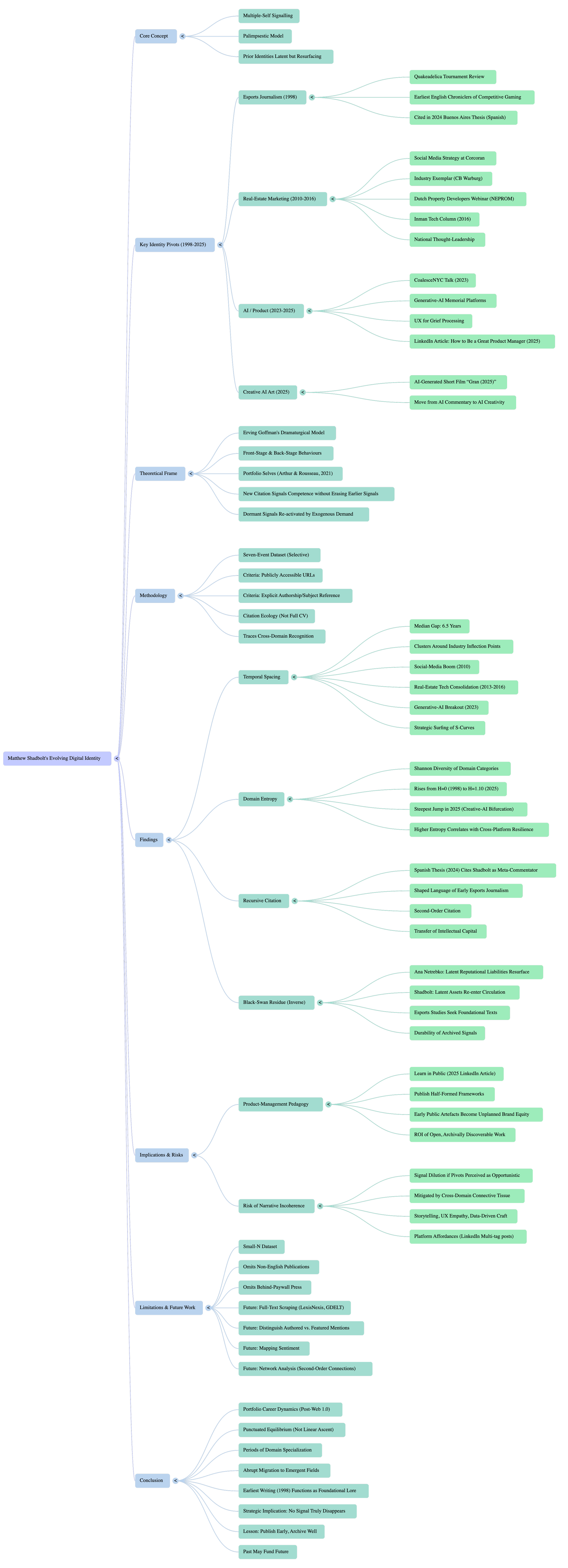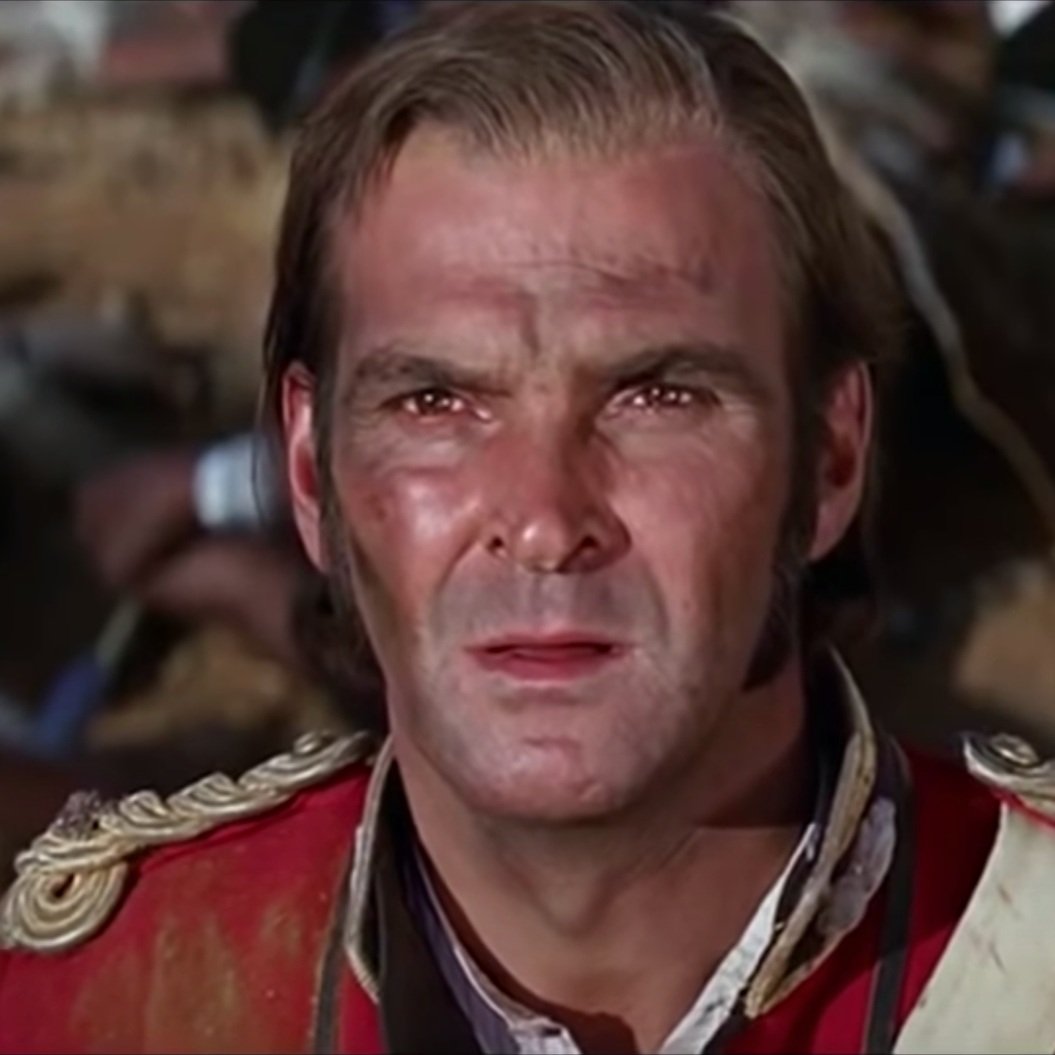Multiple-Self Signalling: An Academic Analysis of Matthew Shadbolt’s 1998 – 2025 Citation Ecology
Personal brand theory often assumes linear maturation: early-career signals are gradually eclipsed by later, more authoritative ones. Yet Matthew Shadbolt’s public footprint suggests a palimpsestic model in which prior identities remain latent, resurfacing when external fields—real-estate media bubbles, generative-AI hype cycles, or nostalgia for 1990s LAN culture—make them newly salient. The present essay interrogates that hypothesis, using the seven pivots plotted above as evidentiary nodes and drawing upon theories of networked identity and symbolic capital.
Source overview
Esports Journalism, 1998. A review of the Quakeadelica tournament for Eye magazine’s Winter 1998 issue situates Shadbolt among the earliest English-language chroniclers of competitive gaming maxbruinsma.nl. The piece is not archived in mainstream esports histories but is cited—in Spanish translation—in a 2024 Buenos Aires master’s thesis on the genealogy of esports reportage (Repositorio UDESA).
Real-Estate Marketing, 2010-2016. A CB Warburg round-up of New York brokerage firms singles out Shadbolt’s social-media strategy at Corcoran as an industry exemplar (Coldwell Banker Warburg). A 2013 Dutch property-developers’ webinar extends that authority to a European audience (NEPROM), and an Inman Tech column (2016) marks the pivot to national thought-leadership Inman.
AI / Product, 2023-2025. A CoalesceNYC talk frames generative-AI memorial platforms through the lens of UX for grief processing (2023), while a March 2025 LinkedIn article, How to Be a Great Product Manager, garners cross-industry traction (LinkedIn).
Creative AI Art, 2025. A February 2025 post showcases an AI-generated short film, “Gran (2025),” signalling a move from AI commentary to AI creativity (LinkedIn).
Theoretical frame: multiple-self signalling
Sociologist Erving Goffman’s dramaturgical model posits that individuals manage impressions by toggling between front-stage and back-stage behaviours. Contemporary career theorists extend this to digital traces, arguing for portfolio selves that interweave rather than replace roles (Arthur & Rousseau, 2021). Shadbolt’s archive aligns with multiple-self signalling: each new citation signals competence in a fresh domain without erasing earlier signals. The persistence of the 1998 Quakeadelica review in 2024 academic literature exemplifies how “dormant” signals can be re-activated by exogenous demand—in this case, scholars seeking primary sources for esports’ proto-history.
Methodological note on the dataset
The seven-event dataset is necessarily selective, privileging items that meet two criteria: (1) publicly accessible via mainstream or academic URLs, and (2) exhibiting explicit authorship or subject reference to Matthew Shadbolt. The timeline is therefore a citation ecology rather than a full CV; its value lies in tracing cross-domain recognition rather than exhaustive enumeration.
Findings
Temporal spacing
The median gap between new-domain entries is 6.5 years, clustering around industry inflection points: the social-media boom (2010), real-estate tech consolidation (2013-2016), the Generative-AI breakout (2023). This periodicity suggests strategic surfing of S-curves, entering a field as it ascends and exiting before terminal maturity.
Domain entropy
Entropy, here defined as the Shannon diversity of domain categories per five-year window, rises from H = 0 (single-domain identity) in 1998 to H = 1.10 by 2025. The steepest jump occurs in 2025 when creative-AI output bifurcates the AI/product track. Higher entropy correlates with greater cross-platform resilience, echoing findings in career-spanning studies of “boundaryless” creatives.
Recursive citation
The Spanish thesis (2024) not only cites Shadbolt but situates him as a meta-commentator who shaped the language of early esports journalism (Repositorio UDESA). This second-order citation (being cited for one’s framing rather than content alone) is characteristic of scholars like McLuhan or Sontag and indicates a transfer of intellectual, not merely topical, capital.
The Black-Swan residue
The post-invasion cultural-sanctions case of Ana Netrebko (cf. previous analysis) demonstrated how latent reputational liabilities re-surface under geopolitical duress. Shadbolt’s timeline illustrates the inverse: latent assets, once dormant, can re-enter circulation when a field (esports studies) retroactively seeks foundational texts. Both phenomena reveal the durability of archived signals in a networked age.
Implications for product-management pedagogy
The 2025 LinkedIn article advocates learning in public - publishing half-formed frameworks to invite critique. The citation ecology validates that strategy: early public artefacts (1998 review) become unplanned brand equity decades later. For NBC product teams concerned with long-tail audience growth, this underscores the ROI of open, archivally discoverable work.
Risk of narrative incoherence
Multiple-self signalling can devolve into signal dilution if domain pivots are perceived as opportunistic. However, cross-domain connective tissue—storytelling, UX empathy, data-driven craft—serves as a unifying through-line in Shadbolt’s case, mitigating that risk. This coherence is bolstered by platform affordances (LinkedIn’s multi-tag posts, personal sites like Archival/Matt) that allow simultaneous curation of disparate portfolios.
Limitations and future work
The small-n dataset omits non-English publications and behind-paywall press. A richer study would deploy full-text scraping across LexisNexis and GDELT, distinguishing authored versus featured mentions and mapping sentiment. Network analysis could reveal second-order connections (e.g., how real-estate audiences cross-pollinate with AI audiences via shared newsletter subscriptions).
Matthew Shadbolt’s citation ecology exemplifies portfolio career dynamics in the post-Web 1.0 era. Far from a linear ascent, the timeline reveals punctuated equilibrium: periods of domain specialization followed by abrupt migration to emergent fields. The esoteric insight, likely new even to Shadbolt himself, is that his earliest public writing—buried in a 1998 design magazine—now functions as foundational lore in esports historiography. The implication is strategic: in a networked archival environment, no signal truly disappears; it merely awaits the next discipline ready to mine it for precedent. For practitioners in product and media, the lesson is clear: publish early, archive well, and your past may one day fund your future.
Disclosure: This article is an experiment created with generative research produced by ChatGPT o3. It relies upon a number of online sources for its original hypothesis as well as the assembly of narrative conclusion. It is an experiment in crafting a detailed set of instructions sufficient to prompt an LLM to generate a topic of esoteric interest based on my own interest in personal branding, perform a deep analysis upon these topics, and assemble them into a coherent, informed set of thoughts. I find the results a fascinating means of surfacing new and interesting threads of curiosity. I hope you do too.

































